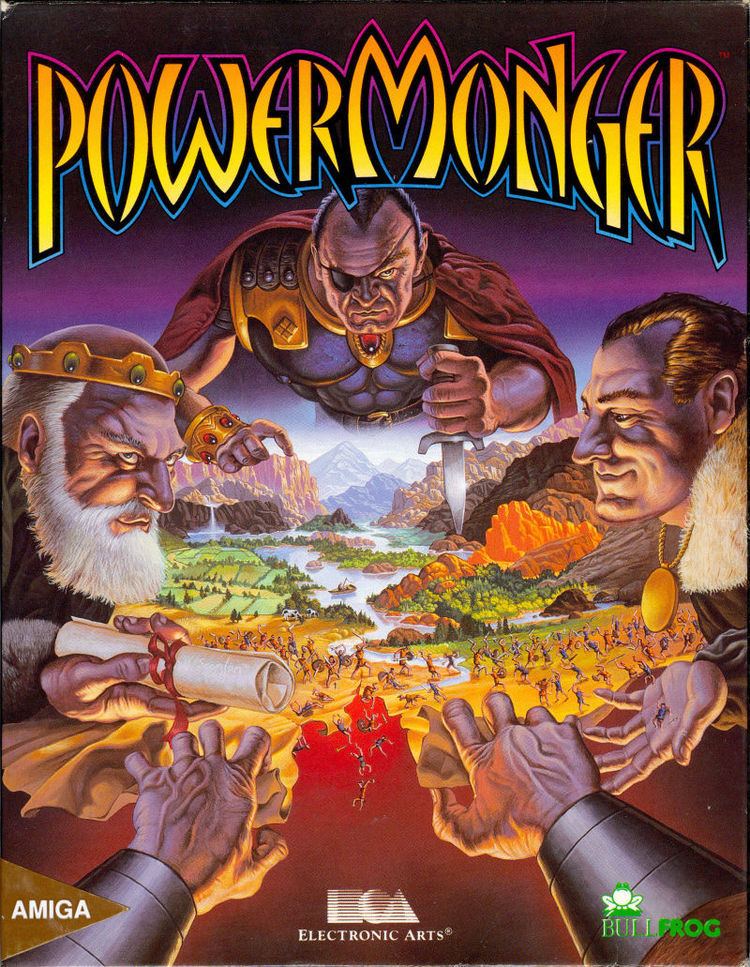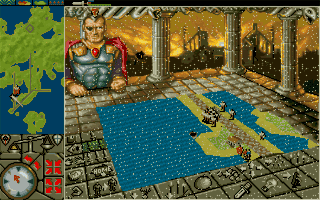8.6 /10 1 Votes8.6
4.5/5 GamesNostalgia | 4/5 Abandonware DOS Initial release date 1990 | |||||||||||||||||||||||||||||||||
 | ||||||||||||||||||||||||||||||||||
Similar Bullfrog Productions games, Real-time strategy games | ||||||||||||||||||||||||||||||||||
Powermonger amiga bullfrog ea 1990
Powermonger (or Power Monger) is a real-time strategy game developed by Bullfrog in 1990, derived from the Populous engine but presented using a 3-dimensional game map.
Contents
- Powermonger amiga bullfrog ea 1990
- Powermonger random map amiga 500
- Gameplay
- Powermonger World War I Edition
- Reception
- References

Powermonger random map amiga 500
Gameplay

The game features a 3-dimensional game map, although camera movement is limited to rotating the map by 90 degrees or small discrete intervals and 8 pre-defined levels of zoom. Only the map topography itself is 3-dimensional; people, trees and other game objects are 2-dimensional sprites.

The game also features a fairly advanced (for its time) "artificial life" engine. Each person seems to have a mind of their own and will go about his or her job, fishing, farming, shepherding, collecting wood or making items without any input from the player. You also have a query tool that can be used to see the name, sex, age, allegiance, vital stats, hometown and equipment for any given person you click on. This aspect of the game has some clear resemblances (though less advanced) with the later Black & White game also designed by Peter Molyneux.

While the player cannot form the land like in Populous, actions can still have some limited effect on the environment. For example, if a large area is deforested, the weather pattern will change and more rain or snow (depending on season) will fall, making movement slower.

The player starts out on each map with a small number of soldiers, and maybe a few towns already under control. To win the map, the balance of power needs to be tipped completely to the player's side (represented by a scale below the mini-map), by conquering all (or at least most) of the towns on the map, and killing any opposing captains. Once a town is under the player's control, locals can be drafted into the player's army and bigger towns or enemy armies can be taken on. Some of the bigger towns also have neutral captains and if these survive the battle they come under the player's command as well.
The player can only control as many armies as captains, so it is important to keep them alive. If a captain is killed, his army is disbanded and his surviving soldiers go back to their town of origin. Unlike the player's main army – which the main character commands – the subordinate captains have a "lag" time (indicated by a tiny homing pigeon animation next to their command icon) before their commands are executed. The further away from the player's main character they are, the longer it takes for orders to reach them.
Food is the single most important resource in the game. Aside from friendly towns the player can also slaughter wandering sheep, barter food from neutral towns, or kill an enemy captain and pillage his food supply.
Aside from manpower and food, towns can also provide equipment. Townspeople will occasionally make items but to speed things up the player can order an army to "invent" at a friendly town. Depending on nearby resources and what posture the army is set to (passive, neutral or aggressive), men will then go to work collecting resources and make items. As the more useful items can usually only be made in one or two towns on any given map these have great strategic importance.
There is no micromanagement involved with equipment. Once an army is ordered to equip itself from a pile of equipment it is automatically distributed. If there are bows, swords and pikes available, soldiers will pick them up in that order. As long as there are soldiers without any weapon in the army no one will pick up more than one weapon. If everyone has something then people with the least valuable weapon will have first pick and so on. The captain carries any excess equipment. There is no limit to how much a captain can carry, but the more he carries the slower he (and his army) will move.
Powermonger: World War I Edition
In 1991 an expansion set (for computers only) was released that changed the setting from the conquest of a medieval kingdom, to World War I. The game play was still essentially the same, but with more ranged weapons and war-machines.
Reception
The game got 5 out of 5 stars in Dragon. Computer Gaming World in 1991 praised PowerMonger as "simply superb ... a joy to play". The magazine favorably cited the graphics and realism, but criticized its unusually strict copy protection and the need to load a saved game twice to return to the previous state. In a 1993 survey of pre 20th-century strategy games the magazine gave the game three stars out of five.
Reviewing the Sega CD version, GamePro criticized the graphics, commenting that "the maps are so pixelated that you can barely see what's going on or who's who. After going through lots of slow strategy, a nice visual payoff of your decisions being executed would've really added to the FunFactor." However, they gave the game an overall recommendation based on its slow-paced strategy gameplay. Electronic Gaming Monthly gave it a rave review, applauding the high detail of the simulation, the graphics, the "subtle" sound, and the enormous length of the campaign. They scored it 6.6 out of 10.
It won Computer Gaming World's 1991 Strategy Game of the Year award. The game was ranked the 32nd best game of all time by Amiga Power.
